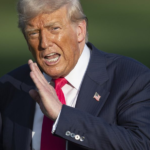2.7% isn’t a very high rate of inflation, to be fair to Trump. In the U.K., by comparison, inflation is 3.6%. The problem for Trump is the direction inflation is going in. It rose 30 basis points. The speed of the rise was “the fastest this century,” according to UBS.
That got the attention of Wall Street. Investors dumped U.S. stocks yesterday. The S&P 500 declined 0.4%. The selling continued globally this morning with Asian and European markets all either marginally down or, at best, flat. S&P futures are marginally down this morning, premarket.
Where is this inflation coming from? It’s coming from Trump, basically. Or at least it is coming from his trade tariffs. For months, economists have been wondering when the higher prices implied by the tariffs will start showing up in the hard data. Yesterday, we got the first signal of the direction of travel.
“Tariff costs are strikingly visible in June’s CPI data. Core goods prices, excluding autos, rose by 0.5%, the most since June 2022,” Pantheon Macroeconomics’ Samuel Tombs and Oliver Allen told their clients. “But only a quarter of the tariff costs has come through so far; expect even bigger price rises in July.”
The tariffs have created a “pipeline” of inflation for the future, according to Deutsche Bank’s Jim Reid and his team. “Household appliances (+1.9%) saw their biggest monthly price jump in records back to 1999. And if you looked at core goods (excluding used cars and trucks) there was a decent +0.32% monthly gain that was the strongest since February 2023. So the fear is that as the tariff impact is more fully felt (with plenty more in the pipeline), those increases could become more widespread across the consumer basket.”
That’s going to feed through into the U.S. government’s borrowing costs. Remember, if inflation moves up then investors demand greater interest payments on debt to account for that. As sure as night follows day, U.S. Treasury yields were pushed up. “As investors digested the print and focused on the more obvious tariff impacts in the various components, Treasuries extended their decline and the 30yr yield (+4.3bps) moved back above the 5% mark again (closing at 5.02%). It’s previously closed above 5% for only 9 days since 2007,” DB’s Reid told clients.
Compounding the problem: The weak U.S. dollar is importing inflation. The dollar is down 9% YTD versus foreign currencies on the DXY index. When American money is weaker, the price of what it buys abroad is relatively higher.
From the stock market point of view, that’s also bad—stocks love cheap money just as much as Trump but the tariff policy is forcing the Fed in the opposite direction.
As the new tariffs kick in—Trump announced pharma and Indonesia in the last 24 hours—expect to see the price of imported goods rise further, and the prospects of a rate cut recede in tandem. Whether the ever-flexible Trump can get out of the cycle he has created remains an open question.
Here’s a snapshot of the action prior to the opening bell in New York:









